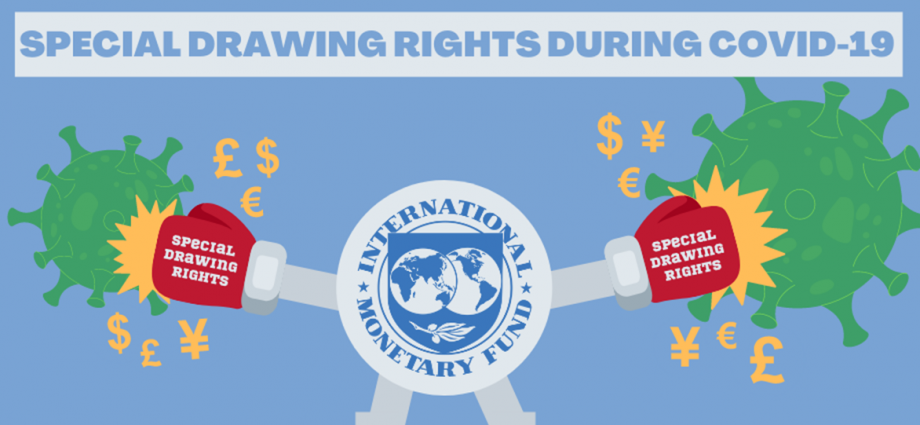Author: Derrick Cui, Graphics: Nina Tagliabue
The BRB Bottomline
In August 2021, the IMF released $650 billion worth of SDRs to all nations to mitigate the impact of COVID on government balance-sheets. Yet, a lack of oversight means free currency was spent indiscriminately.
The COVID pandemic has caused governments and organizations to re-tool pre-pandemic mechanisms not meant for such a crisis, like using finicky accounting to get around debt ceilings, repurposing archaic income subsidies, and pushing monetary policy to its limits to stabilize global finance. The International Monetary Fund’s (IMF) Special Drawing Rights (SDRs) is a prime example and has unintentionally changed from being a currency reserve to free lunch.
What are SDRs?
SDRs were originally invented by the IMF Bretton Woods fixed exchange rate system as a way to increase liquidity for currency exchanges during a time when currencies were still pegged to gold. Countries essentially bilaterally trade their SDRs for hard currency, which can then be used to pay for imports or stabilize central banks’ balance sheets. Yet as their relevance diminished with floating exchange rates and a stronger global finance system, their breadth of use has dramatically changed. Instead of being a currency reserve, it has become free cash flow.
Generally speaking, Special Drawing Rights are claims to currency (5 currencies to be exact) with the purpose of stabilizing currency reserves. Based on a myriad of factors but mainly based on economic size, each country in the world is handed SDRs. Before COVID, there were 204 billion SDRs in total. In August 2021, approximately 456 billion new SDRs ($650 billion USD) were allocated to countries, more than tripling the total number of SDRs in existence. Of these 456 billion SDRs, 79 billion went to the US, the largest recipient.

With Greater Power comes Fewer Responsibilities
Even before COVID, countries realized the power of SDRs because of their lack of oversight. They were regularly used to purchase goods, prop up currencies, pay back private creditors, and use in fiscal budgets.
During COVID, this extreme injection of currency has been an opportunity for poor countries to service public debts, buy vaccines, fund healthcare, mitigate job losses, and prevent famine. Yet SDRs were never designed to be a form of humanitarian aid and its cracks are showing.
First of all, since SDRs are given based on economic size, only 3 percent of the $650 billion USD total in pandemic response went to low-income countries and only 30% went to middle-income countries. Secondly, these transfers have become slow and tedious, as rich countries have to agree to trade their currency for SDRs. Though some countries have stepped up as white knights (notably France and Japan), most rich countries are slow to trade. Thirdly, SDRs are given to everyone as a way to stay impartial, inadvertently legitimizing rogue nations, like Iran receiving $5 billion USD and Belarus $1 billion. These essentially counter the effect of sanctions and also fund weapon purchases which exacerbate conflict. Fourth, unlike other types of funding from the World Bank or other lenders, there is no oversight. Argentina, for example, has used dubious accounting to dodge limits on fiscal spending and double how much in SDR’s they appear to have, using it to both pay back IMF loans and create central bank credit lines. Given Argentina’s track record of overspending and defaulting, economists are looking worryingly at the country’s future. Finally, critics also note that some countries have used this money not for covid-related expenditure but to boost government incomes and pay off loans like those from China’s Belt and Road Initiative.
Yet some argue that SDRs have become an integral part of global finance. After all, they still are relatively fast ways for poorer nations to be guaranteed foreign cash and are a refuge for countries that have huge borrowing costs. Removing SDRs would only destroy a means of currency exchange that some countries rely on. After all, much of the 456 billion SDRs exchanged was put to social spending, COVID-related support, and the importing of vital goods and services.
SDR’s have undoubtedly become free cash for all countries instead of being a currency reserve asset. However, it seems near impossible nowadays to change the structure of SDR’s given its enshrinement in the IMF and countries’ dependence on it for foreign currency.
Take-Home Points
- In August 2021, the IMF released $650 billion worth of SDRs, tripling the total number of SDRs in existence
- SDRs have evolved from being currency stabilizers to free flowing cash
- SDRs are ill-suited for COVID-19 because a small proportion are given to poor countries, they require cooperation from rich countries, are given to everyone including rogue nations, have no oversight, and can encourage corruption
- Yet it it still a vital part of global finance as some countries still depend on it to balance their books, import vital goods and services, and work around high borrowing costs

